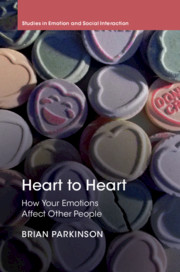Book contents
- Heart to Heart
- Studies in Emotion and Social Interaction
- Heart to Heart
- Copyright page
- Dedication
- Contents
- Figures
- Preface
- Acknowledgements
- Chapter 1 What’s at the Heart of Emotions?
- Chapter 2 Words and Concepts
- Chapter 3 Facial Activity and Emotion Expression
- Chapter 4 Explaining Emotional Influence
- Chapter 5 Regulating Emotions
- Chapter 6 Social Functions
- Chapter 7 Groups, Teams and Crowds
- Chapter 8 Working with Emotions
- Chapter 9 Reorientation
- References
- Index
- Studies in Emotion and Social Interaction
Chapter 7 - Groups, Teams and Crowds
Published online by Cambridge University Press: 28 October 2019
- Heart to Heart
- Studies in Emotion and Social Interaction
- Heart to Heart
- Copyright page
- Dedication
- Contents
- Figures
- Preface
- Acknowledgements
- Chapter 1 What’s at the Heart of Emotions?
- Chapter 2 Words and Concepts
- Chapter 3 Facial Activity and Emotion Expression
- Chapter 4 Explaining Emotional Influence
- Chapter 5 Regulating Emotions
- Chapter 6 Social Functions
- Chapter 7 Groups, Teams and Crowds
- Chapter 8 Working with Emotions
- Chapter 9 Reorientation
- References
- Index
- Studies in Emotion and Social Interaction
Summary
Emotions not only affect other people individually but also also help to form and consolidate wider social alliances or divisions. This chapter focuses on emotion’s effects and functions in group life and on how interpersonal processes might scale up to produce collective outcomes. Ingroup members’ emotions signal their shared or distinct social identities and communicate relevant group norms, as well as aligning intragroup relations more directly. Mutual entrainment of movements may be facilitated by temporally structured interaction rituals, and joint participation in collective action can reinforce a sense of efficacy and shared purpose. Emotions not only align relations within groups but also between them. Like interpersonally targeted emotions, intergroup emotions are often attuned to actual or anticipated responses from their targets and respond directly to emotional feedback from the outgroups at which they are directed. Many theorists explain these social-functional outcomes by reference to single-minded processes of self-categorization and group-based appraisal, paying relatively less attention to the relation-aligning consequences of the collective enactment of identities. However, group emotions make most sense when grounded and contextualised in processes of group mobilization and intergroup exchange.
Keywords
- Type
- Chapter
- Information
- Heart to HeartHow Your Emotions Affect Other People, pp. 241 - 274Publisher: Cambridge University PressPrint publication year: 2019



